This post may contain references or links to products from one or more partners of our parent company and/or subsidiaries of our parent company. For more information, visit this page.
July 10, 2023
Morning sunshine? Check. Hot coffee in a heavy mug? Check. Fuzzy socks sliding across smooth floors? Check. Oh yes, friend. We’re talking about sunroom flooring. From spring to fall, your sunroom provides a bridge between the great outdoors and the comfort of your home. And if you’re one of the lucky ones in California or Florida (jealous), your sunroom can be used all year round.
Best Floors for a Sunroom:
While there are considerations you should take, there are a few brands that you can’t go wrong with when choosing sunroom flooring. We recommend;
Newton
Visit their site | Find a retailer | Order samples
Liberty Home
Visit their site | Find a retailer | Order samples
But whether you have a sunroom, an enclosed porch, or a three-season room, choosing your flooring is a crucial decision—and it’s not as simple as rolling by Home Depot to grab a few rolls of whatever speckle-print linoleum is on sale this week (if only!).
Because while soft breezes and birdsong are a huge plus for many homeowners, a sunroom’s gentle exposure to nature creates a huge challenge when choosing between different types of flooring. Your sunroom flooring needs to defend against a yearly grab-bag of moisture, heat, cold, and sun. It should resist scratching, peeling, and fading. And of course, it should match your taste and creative vision.
So: if splinters are snagging your socks or if a chunk of Nixon-era linoleum peels up every time you move a potted plant, it’s time to give your well-loved sunroom flooring a facelift. You need a surface that’s ready for muddy feet, cold snaps, and humid summers.
That’s why we’ve put together this list of the 5 best sunroom flooring options around. Each one looks great and stands up to rugged wear—the only question is: which is best for you? Let’s find out!
Sunroom, Three-Season Room, or Enclosed Porch: What’s the Difference (and Why Does it Matter?)
Ok, before you take your first step towards sunroom flooring enlightenment, we need to determine whether you have a sunroom, a three-season room, or an enclosed porch. Different types of rooms need different types of flooring, and what works for one might not work for the other!
- A sunroom is any exterior room with many windows and direct access to the outdoors, usually positioned to receive steady streams of natural light.
- A three-season room is an unheated sunroom, usually less insulated, and vulnerable to the extremes of heat and cold.
- Enclosed porches are screened rooms with even less protection from the elements—meaning they need durable outdoor flooring options.
It’s simple—the more insulated your room is, the more flooring options you have. Even gentle exposure to the elements changes the game when choosing a sunroom floor.
Will it burn your bare feet after baking in the summer sun, or get uncomfortably cold and clammy in the winter? Will it survive when your kids inevitably forget to close the windows before a rainstorm? Will you need scratch-resistant flooring because your feisty labrador doesn’t like her nails trimmed? These are all things you should take into consideration when choosing your sunroom flooring.
The 5 Best Sunroom Flooring Options
Now that we understand the differences between sunrooms, three-season rooms, and enclosed porches, we’re ready to talk about specific flooring options. One of these amazing types of flooring will certainly do the job!
Best Brands of 2024
#1. Laminate: Resilient and Stylish
Laminate flooring has come a long way since its days as the go-to for sagging church basements and dusty waiting rooms. We think it won the linoleum vs. laminate debate long ago, so banish any visions of peeling or plasticky surfaces from your mind. With elegant finishes and affordable pricing, modern laminate is a worthy contender in the battle for sunroom supremacy.
But before we continue singing its praises, exactly what is laminate flooring made of? It’s simply a sandwich of fiberboard, an image layer, and a super-durable plasticate wear layer. It can stand up to heavy foot traffic, dragging chair legs, and scratches—so pet (and child) owners, perk up!
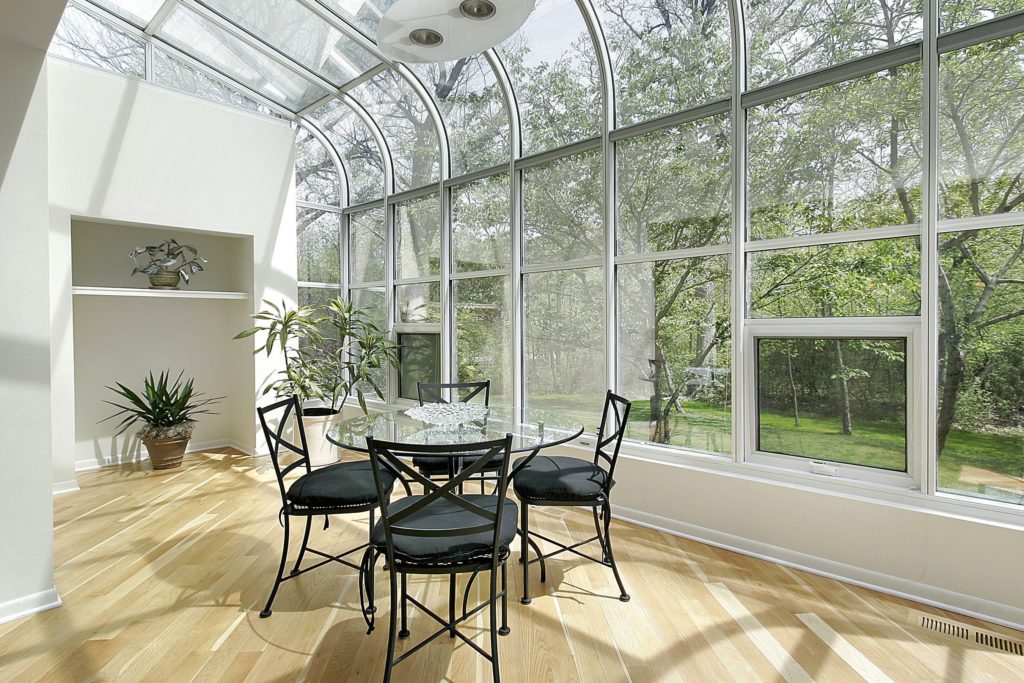
Laminate is super durable, but not waterproof
While some manufacturers now claim to make a waterproof laminate, it’s not usually a fully waterproof flooring option. That said, laminate is a great choice for sunrooms—especially in lighter shades or with UV-coated finishes that resist fading.
But keep an eye on the sky if you’re outfitting a three-season room or enclosed porch, because laminate’s fiberboard base layer will be susceptible to water damage over time. If you live in an arid or sunny climate, laminate does an outstanding job on less-insulated porches even if you expect them to receive rough treatment. But if your flooring could get caught in a downpour without an umbrella, tile might be a better bet.
Laminate can look like hardwood
The heart wants what it wants—but even if your heart (or your spouse’s) is pre-set on hardwood floors, don’t count out laminate. Modern laminate’s photorealistic image layer can make it incredibly difficult to tell the difference between a laminate vs. hardwood floor. Laminate could be the solution if you crave the look of wood grain without the price tag (or the durability issues of a natural product).
Beyond being a great impressionist of natural finishes, laminate comes in so many different patterns and styles that we’re sure it was voted “Most Artistic” in it’s graduating class. Whether you want a zesty, subtle, or statement sunroom, if you don’t expect too much rain or humidity, laminate is a great way to go.
#2. Vinyl Plank Flooring: Durable and Waterproof
If you’re flooring an enclosed porch in a climate closer to rainy Rochester than sunny Sedona, consider vinyl plank flooring. Vinyl plank flooring, or “LVT”, is a synthetic (plastic) floor that expertly mimics hardwood or stone. Resilient and gorgeous, LVT is one of the best types of vinyl flooring for indoor/outdoor spaces—especially when water resistance is a must.
Vinyl plank creates waterproof and gorgeous sunroom flooring
Vinyl plank is waterproof and crazy durable, which makes it a great floor for humid climates. Because the production process has become quite advanced, it can be really difficult—if not impossible—to tell the difference between high-quality vinyl plank flooring and solid hardwood. Much like hardwood, vinyl plank can be laid in a kaleidoscope of different wood floor designs, elegant enough to please any dreamer with a subscription to Architectural Digest.
Just make sure your LVT has UV protection
Vinyl plank is a standout for your enclosed porch or three-season room, but be a clever consumer if you’re purchasing flooring for a sunroom that receives intense, sustained light. Even though most vinyl plank products have UV-resistant wear layers, some can occasionally fade in sunlight. And although they’re super-durable, some types of flexible vinyl plank floors might scratch or dent—especially under the weight of heavy furniture or sustained wear.
#3. Engineered Hardwood: Affordable and Beautiful
Engineered hardwood flooring isn’t a “lite” version of the real thing—it is the real thing. With added benefits! We know, it’s hard to justify the wood flooring cost for a space that, for at least some of the year, can be a glorified storage room (looking at you, February).
But using engineered hardwood in your sunroom or three-season room gives you the look of irresponsible luxury without the cost of a traditional hardwood floor.
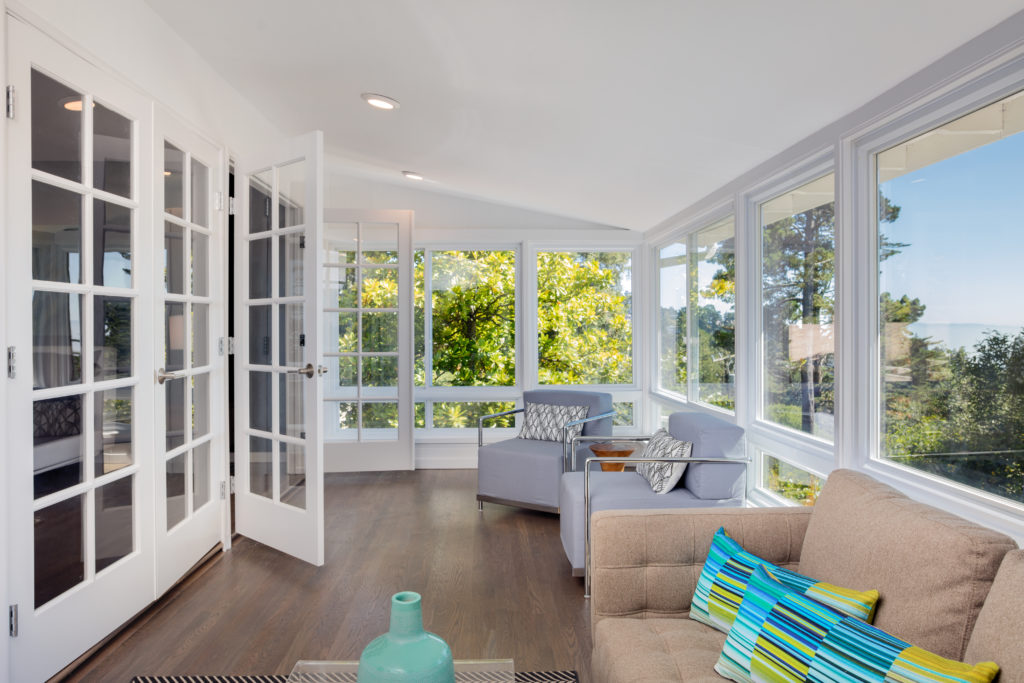
Engineered hardwood is more resistant to changes in temperature and humidity
Calling engineered hardwood “fake wood flooring” doesn’t do justice to this innovative material, and we simply won’t stand for it (though we will stand on it). Engineered wood might not be solid throughout, but it is real hardwood—oak, mahogany, even teak—fixed to a fiberboard or plywood core.
Almost all of the best hardwood floor brands offer engineered wood products. And when you’re buying hardwood flooring for your sunroom, this means flexibility—because engineered wood is more resistant to changes in temperature and humidity than solid wood is. That means you can put it in sunrooms and three-season rooms!
Plus, the best engineered wood flooring uses high-quality materials, a thick veneer, and behaves the same as traditional wood. Once it’s installed in your sunroom, it’s virtually impossible to tell the difference.
Engineered hardwood is an affordable sunroom floor
Because it uses less solid material, engineered hardwood is often more affordable than solid wood—especially if you’re going with an exotic species. And since it can usually be purchased as click-together flooring, it can be easier to install for do-it-yourself flooring projects too.
And speaking of installation: the cost to install engineered hardwood floors is roughly the same as it is for solid hardwood, but only if you’re using a domestic wood species. As we mentioned earlier, if you’re considering an exotic species like Brazilian Walnut, you’ll typically save more when you opt for engineered over solid.
Engineered hardwood behaves like regular hardwood
Compared to solid types of wood flooring, engineered hardwood is a safer bet in a three-season room or an enclosed porch in a mild climate. But think carefully—both solid and engineered hardwood can be risky if your sunroom flooring receives constant exposure to rain and sun.
Even though engineered hardwood is one of the most durable wood flooring options around, you might consider vinyl, laminate, or other hardwood floor alternatives before committing to refinishing every couple of years. And if you’re planning on heating your wood floor, stick to solid wood—too much heat under engineered wood can mean permanent swelling.
Lustrous and classic—hardwood won our hearts and minds long ago. But the best hardwood floors are ones that fit the needs of your space and your budget, and engineered hardwood floors do both. But it can be difficult to know how to install hardwood floors correctly without prior experience, so don’t be afraid to ask a professional from a local flooring retailer for advice!
#4. Carpet Tile: Warm, Fuzzy, and Easy to Replace
Carpet in the sunroom, carpet on the porch? That’s crazy talk! To some, the idea of carpeting an indoor/outdoor space brings back horrible memories of the unfortunate trend of carpeted bathrooms in the 1970s. We’ve already covered some more durable, resistant flooring options, but what if your sunroom vision includes walking barefoot through downy, high-pile carpet?
If you’re unpersuaded by the carpet vs. laminate debate and already picked your winner in the carpet vs. hardwood showdown, we can’t blame you—carpeting has a special allure for its comfort, warmth, and homey feel. It’s come a long way in stain resistance, hypoallergenic qualities, and durability. And thanks to modular solutions like carpet tiles, even indoor/outdoor rooms that were no-go zones for carpeting can now enjoy its cozy embrace.
Carpet tiles keep your feet warm
Carpeting in a sunroom or three-season room makes perfect sense, especially in colder months. Carpet keeps feet insulated from the winter chill, and it can absorb and hold warmth from sunlight in a way tile or laminate simply can’t. Sorry, enclosed porch owners—we simply can’t endorse using carpet, even carpet tiles, on a porch. Unless, of course, you want to replace them after every rainstorm!
Carpet tiles are easy to replace
Unlike wall-to-wall carpet, peel-and-stick carpet tiles are simple to install and easy to replace. They come in an endless range of materials, patterns, colors, and piles—all of which you can mix and match to create your own custom carpeting. Plus, you can buy them by the crate from Lowes, Home Depot, or even Amazon.
Once you have the basics of how to install carpet tiles, it’s easy to replace a single tile (or the entire path from the kitchen to the backdoor). And considering the usual cost to replace carpet with hardwood or another rigid material, carpet tiles are a creative way to enjoy the benefits of carpeting without being stuck with stained or worn sunroom flooring. Plus, you can install them directly on top of your existing surfaces. No demolition or removal needed!
#5. Tile: Classic and Creative
Need scratch- and scuff-resistant sunroom flooring that’ll stand up to soccer cleats, tapdancing shoes, and just about anything else? Dreaming of a sunroom overflowing with vines, potted palms, and philodendrons for those #urbanjungle vibes? Tile has long been the go-to flooring for sunrooms, and we see why.
It’s easy to clean, durable, and (when properly grouted) is totally waterproof. It’s a favorite for mudroom flooring for the same reasons. From frenzied mosaic patterns to respectable quarry squares, the types of tile at your disposal can fit any creative vision.
Just remember: tile doesn’t like extreme conditions
But before you start looking at glaze shades, break out your farmer’s almanac. While it’s unmatched in water resistance, tile (especially concrete and unglazed tile) doesn’t like extreme shifts in heat and cold.
If you live in a freeze-and-thaw climate, and especially if you’re flooring an unheated three-season room or enclosed porch, carefully weigh the benefits of tile vs. laminate before choosing. Laminate isn’t waterproof, but it is less rigid and can expand and contract without cracking.
And while it’s extremely durable, it can crack under heavy weight—so leave those barbells downstairs. Traditional tile is not easy to lay on your own, but if you’re handy take a look at snap-together tile flooring—it locks together to float above the existing floor surface.
Tile will keep your sunroom flooring cool. Really cool.
We hope you haven’t tossed that almanac back onto the toilet tank—because you still need to consider the feel of your sunroom tile throughout the year. Tile stays cooler in the summer, but in winter it can get downright chilly.
If you have rugs on hand, keep them—or consider the benefits of a tile vs. wood floor, as affordable engineered hardwood will absorb and hold heat. That said, you really can’t beat the amazing patterns and hipster-perfect feel you’ll get with a tile floor.
How to Start Reflooring Your Sunroom
Depending on your choice of sunroom flooring, you may be in for a fun weekend of sticking down carpet tiles or reading through reviews for a trustworthy grouting specialist. If you don’t know how to replace flooring yet, do your research—but don’t hesitate to call in the big guns and hire a professional.
Whether it’s laminate, vinyl plank, tile, or carpet, one of these 5 types of flooring will define your sunroom for years to come. So do the smart thing and find a flooring store near you—they can help you with everything from selecting to installing your sunroom flooring. And for more info, check out:
- What is Subflooring? Underlayment? We’ll Explain.
- The 8 Best Types of Wood Flooring For Dogs
- Is the Cork Flooring Lowes Sells Actually Worth Buying?
- Why Concrete Flooring That Looks Like Wood is So Darn Cool
- Your Complete Guide to Bamboo Flooring
- The Best Cork Flooring Options & 11 Reasons They’re Awesome
- The Pros and Cons of Cork Flooring
- Pergo Reviews 2020: What Buyers are Saying
- The Advantages and Disadvantages of Floating Floors
- Bamboo Flooring vs. Laminate: Which Should You Buy?
- Engineered Bamboo Flooring: The Pros and Cons
About The Author

Rose Mraz
June 23, 2020
Rose's career has taken her from small-town teacher to mixologist at several award-winning NYC cocktail bars (and everywhere in between). These days, she plies her craft as an SEO writer specializing in the confluence of wellness, politics, and the service industry.
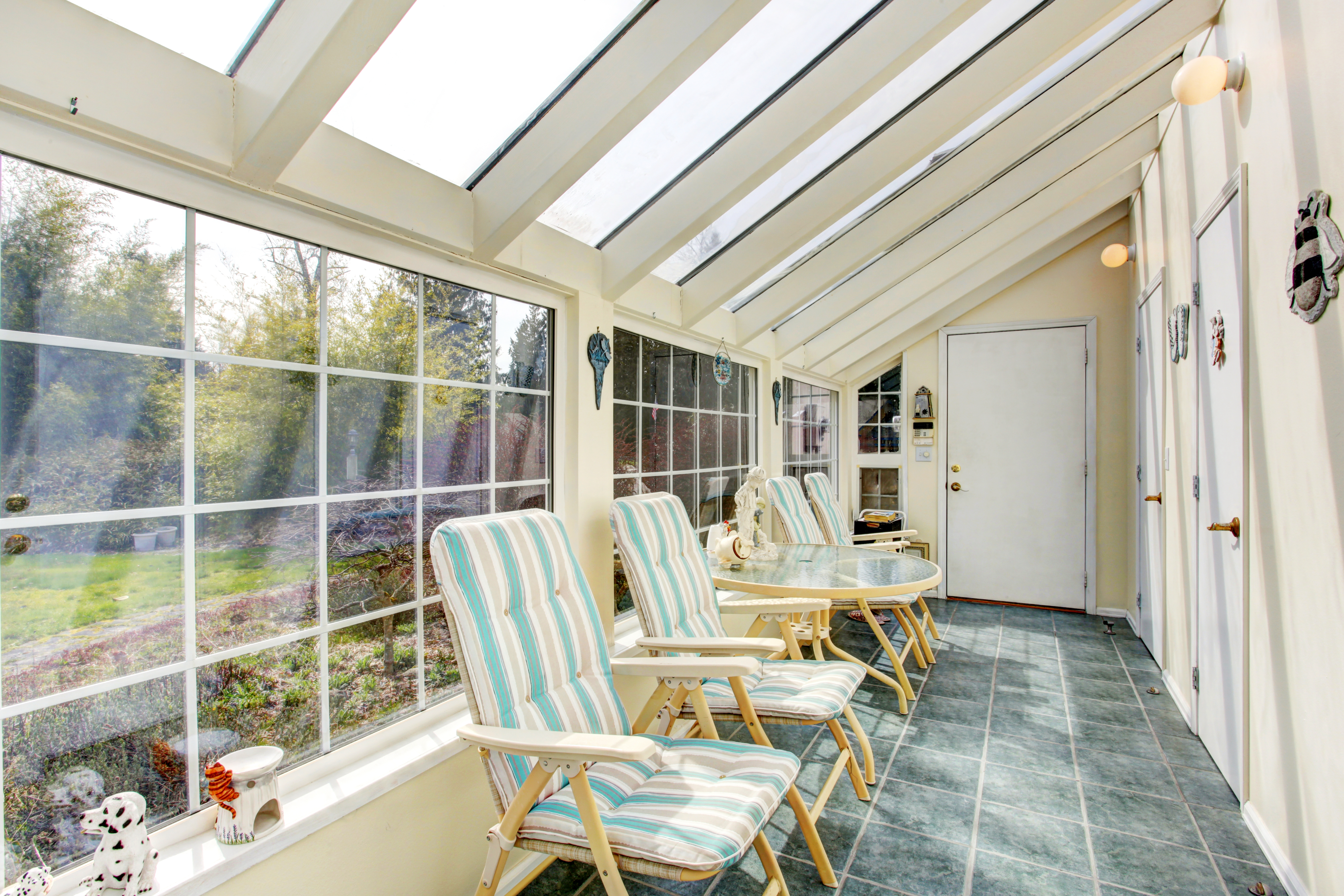
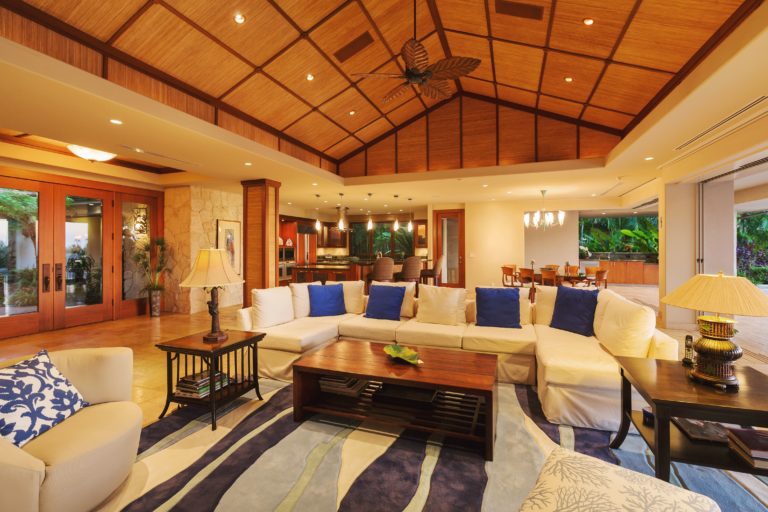

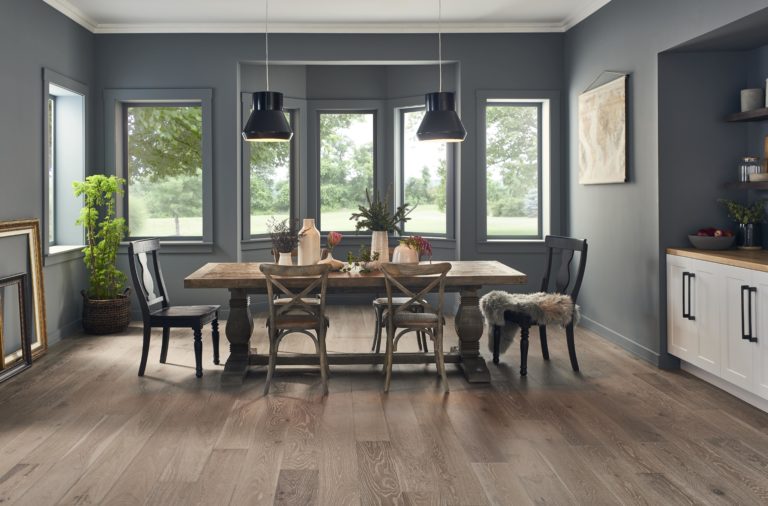



2 comments
Afton Jackson
It was really surprising to read that vinyl floors can come with special designs that can mimic other types of wood. I would have already opted for hardwood for most of the rooms in our house but the fact that it doesn’t deal with water very well has me second-guessing myself. Vinyl flooring could be the solution I need, so I’ll look for any flooring contractors that can get me some and install it into our guest rooms.
Samuel Greenberg
Hey Afton,
Honestly, looking and feeling different vinyl plank flooring samples absolutely blew our minds. They’re so incredibly realistic! Even as flooring people, we’re shocked each and every year by how identical LVP is getting to the real thing.